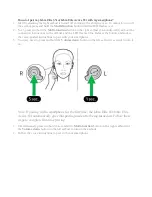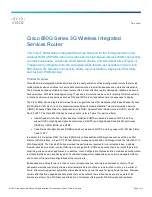
LEON-G100 / LEON-G200 - System Integration Manual
GSM.G1-HW-09002-G3
Preliminary
System description
Page 75 of 125
Pad disabled
:
All the GPIOs (
GPIO1
,
GPIO2
,
GPIO3
,
GPIO4
and
HS_DET
) can be configured in tri-state with an internal
active pull-down enabled, as a not used pin, setting the parameter <gpio_mode> of +UGPIOC AT command
to 255.
The pin configured to provide the “Pad disabled” function is set as
o
Tri-state with an internal active pull-down enabled
1.12.2
LEON-Gx00-04S and LEON-Gx00-05S versions
LEON-Gx00-04S and LEON-Gx00-05S versions provide 2 general purpose input/output pins:
GPIO1
and
GPIO2
.
The available functions are described below:
GPS supply enable
:
GPIO2
is by default configured by AT+UGPIOC to enable or disable the supply of the u-blox GPS receiver
connected to the wireless module.
The
GPIO1
pin can be configured to provide the “GPS supply enable” function, alternatively to the default
GPIO2
, setting the parameter <gpio_mode> of AT+UGPIOC command to 3.
The pin configured to provide the “GPS supply enable” function is set as
o
Output / High, to switch on the u-blox GPS receiver, if the parameter <mode> of AT+UGPS
command is set to 1
o
Output / Low, to switch off the u-blox GPS receiver, if the parameter <mode> of AT+UGPS
command is set to 0 (default setting)
The pin must be connected to the active-high enable pin (or the active-low shutdown pin) of the voltage
regulator that supplies the u-blox GPS receiver on the application board.
Network status indication
:
Each GPIO (
GPIO1
or
GPIO2
) can be configured to indicate network status (i.e. no service, registered home
network, registered roaming, voice or data call enabled), setting the parameter <gpio_mode> of
AT+UGPIOC AT command to 2.
No GPIO pin is by default configured to provide the “Network status indication” function.
The pin configured to provide the “Network status indication” function is set as
o
Continuous Output / Low, if no service (no network coverage or not registered)
o
Cyclic Output / High for 100 ms, Output / Low for 2 s, if registered home network
o
Cyclic Output / High for 100 ms, Output / Low for 100 ms, Output / High for 100 ms, Output / Low
for 2 s, if registered visitor network (roaming)
o
Continuous Output / High, if voice or data call enabled
The pin can be connected on the application board to an input pin of an application processor or can drive a
LED by a transistor with integrated resistors to indicate network status.
General purpose input
:
All the GPIOs (
GPIO1
,
GPIO2
) can be configured as input to sense high or low digital level by AT+UGPIOR,
setting the parameter <gpio_mode> of +UGPIOC AT command to 1.
No GPIO pin is by default configured as “General purpose input”.
The pin configured to provide the “General purpose input” function is set as
o
Input, to sense high or low digital level by AT+UGPIOR
The pin can be connected on the application board to an output pin of an application processor to sense the
digital signal level.
General purpose output
:
All the GPIOs (
GPIO1
,
GPIO2
) can be configured as output to set the high or the low digital level by
AT+UGPIOW, setting the parameter <gpio_mode> of +UGPIOC AT command to 0.
GPIO1
is by default configured by AT+UGPIOC as output to set high/low digital level by AT+UGPIOW.
















































